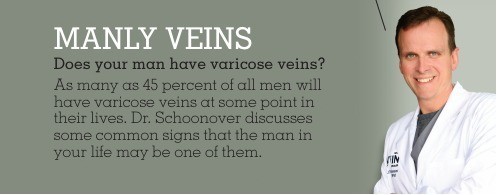News
After 40: Mens Varicose Veins


Do men have varicose veins less often than women?
Yes, but the difference is not as great as you might think. You may be surprised to learn that 55 percent of women will suffer from varicose veins, compared to 45 percent of men.
I know a lot of women get varicose veins due to pregnancy, but what causes them in men?
The number one cause of varicose veins in both men and women is family history. If his mom or grandmother had varicose veins, he is more likely to have them. Lifestyle factors play a significant role as well. If he has a job that requires him to stand for long periods, such as medical professionals, factory workers, sales or restaurant occupations, he is more likely to get varicose veins. If he travels and spends long hours flying or driving, or if he sits at a desk for several hours at a time, he is at risk as well. Varicose veins can even be the result of previous leg trauma. Varicose veins can affect men of all ages, but the risk increases with age because of the loss of tissue tone and muscle mass, as well as a weakening of the venous walls.
What are some of the symptoms of varicose veins in men?
If he keeps you awake at night with restless legs, that may be a sign he has varicose veins. If you cannot get him to take a walk with you because of leg pain, or if he doesn’t play with the kids or grandkids like he used to, that could be another sign. Generally men have the same symptoms as women: pain, leg heaviness, tiredness, muscle cramps and swelling. However, men are less likely to seek medical treatment. It is important that you encourage him to seek consultation if he is experiencing any of these symptoms.
Does not getting treatment make his veins worse?
Absolutely. Like any chronic medical condition, varicose veins will progress without treatment. Because varicose veins are often painful, it is important to treat them in order to maintain an active lifestyle. Treatments such as medical-grade compression stockings and changes in work habits can improve his symptoms but will not address the underlying cause. Severe varicose veins can lead to serious complications, such as skin breakdown and even blood clots.
What treatments do you use to treat men?
Like in female patients, men can undergo endovenous laser treatment, or EVLT. This high-tech laser procedure is performed in our office and only takes about an hour. Guided by ultrasound, we insert a small laser fiber through the skin into the varicosed vein. Laser energy is delivered inside the vein, which causes the vein to collapse and seal shut. Once that vein is closed, the blood reroutes to other healthy veins.
How much time will he need to be off work?
Important to many men is knowing they can go back to work the next day. In fact, many of our male patients have returned to work the same day. Unlike old-fashioned vein stripping, a long convalescence is not necessary.
Is the treatment permanent, or will his varicose veins come back?
One of the major advantages of EVLT is that the recurrence rate is far less than surgical stripping. Some reports show a recurrence rate as high as 30 percent to 35 percent with surgical stripping, while EVLT has a recurrence rate of only about 8 percent after five years.
Will he need any other treatment?
Depending upon his clinical presentation and the results of an ultrasound assessment, he may need sclerotherapy following endovenous laser treatment.
